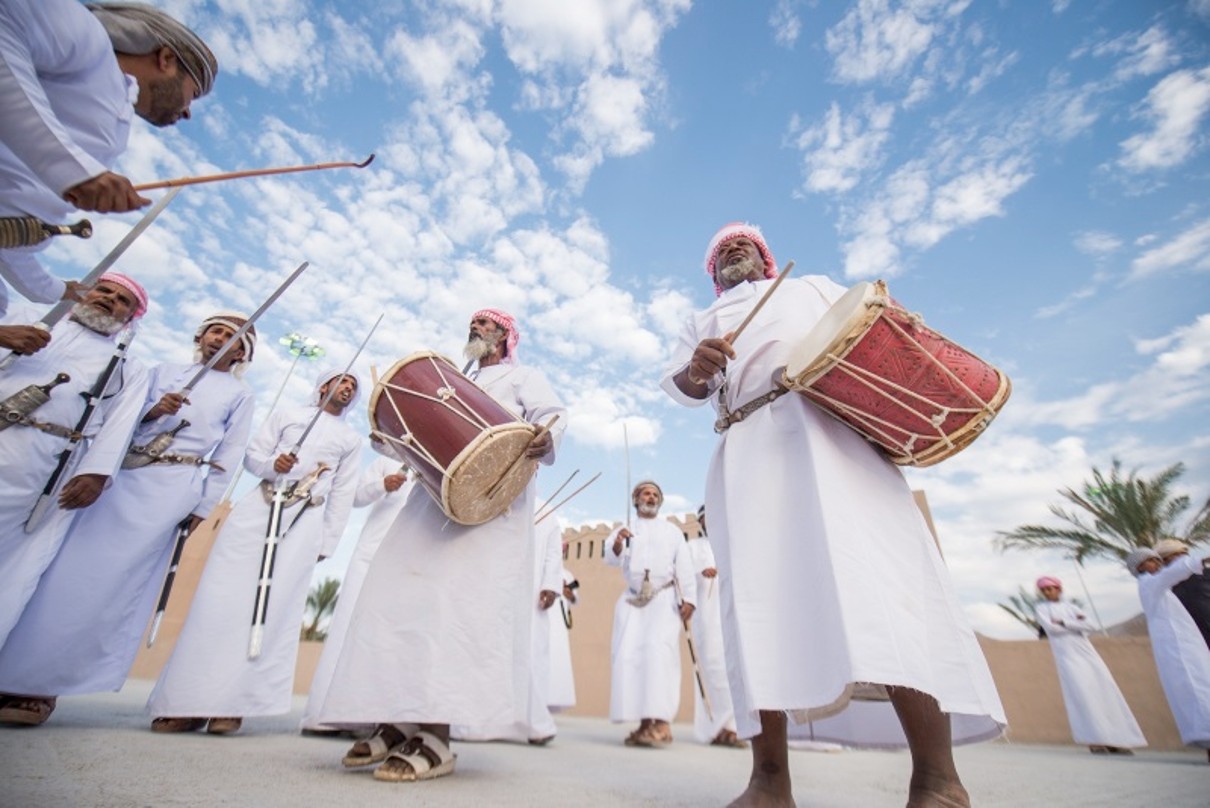Page content
Khanjar, Kumma and Kahwa
To really get to know a country and its culture, it is important to look behind the facades and discover the traditions and customs, ideally during encounters with locals. Oman is a country where many ancient traditions and customs are still alive today and truly incorporated in people’s daily lives. It is a place where hospitality is a way of life and where the smell of Omani coffee and dates welcomes travelers at every encounter. Traditional dress is a symbol of pride, and the ancient khanjar is more than just a cultural symbol. An introduction to five important traditions and customs of the Omani people.
Precious sword: khanjar
The khanjar, Oman's traditional dagger sword, is more than just a weapon or cultural emblem. It is a symbol of masculinity and strength. Originally used by warriors for protection, today, the khanjar is worn as part of traditional attire on special occasions and ceremonies in a belt around the waist. The weapon has a curved blade and a handle decorated with silver or gold ornaments, sometimes even sparkling gemstones. To this day, the khanjar is handmade by artisans who learned the craft from their ancestors. Although the khanjar has been part of Omani culture for centuries, it has also gained international recognition. In 2014, the khanjar was added to UNESCO's cultural heritage list.
Enchanting dress
Another important aspect of Omani culture is the traditional dress worn by locals, distinguished by its colorful and detailed designs. For men, traditional attire consists of a white dishdasha, a long robe that reaches to the ankles. This is often worn in combination with the Kumma (a round, beautifully ornamented hat) or the Mussar (a turban which comes in many different colors). During festive occasions and ceremonies, the traditional dishdasha is worn with a khanjar.
For women, traditional dress consists of an abaya. This is a long robe that covers the entire body. The abaya is often combined with a headscarf called the hijab or a face veil called the niqab and may be black or very colorful, decorated by precious embroidery. Travelers touring Oman will soon see that women's costumes will vary by region. To get an idea of traditional dress in Oman, a visit to the Bait Al Zubair Museum in Muscat is worthwhile.
A taste of Omani hospitality
One of the most common ways for Omanis to welcome guests is to invite them into their “majlis”, a room every typical Omani house has to greet and meet guests. Once having a seat on the comfortable cushions, guests will be offered coffee with dates and halwa, a sweet treat made from honey, ghee and nuts. This tradition is a sign of respect and appreciation in Omani culture and so travelers visiting Oman can enjoy flavorful treats while having encounters with locals. Also, it is customary to have a Frankincense burner with the olibanum waiting in the majlis which fills the room with the incense’s unique scent.
The rhythm of the Omani culture
One of the most vibrant aspects of Omani culture is traditional dancing. Rahza is one of the most famous traditional dances practiced in Oman and is often performed during celebrations and festivals throughout the country. Men leap into the air with swords, catch them and perform synchronous movements to different rhythms.
Another popular dance is the Al-Bar'ah. This dance is mainly performed in the Dhofar Mountains in southern Oman. Accompanied by local drums and flutes, male dancers swing their khanjars above shoulder height while performing various dance moves. Unlike the Rahza, women can also participate in this dance. Al-Bar'ah represents the Bedouin's chivalrous spirit and hospitality. In addition, it emphasises themes of love and flirting.
Dhow sailing
The traditional dhow has been an important part of Oman's maritime history for centuries. The Sultanate of Oman is known as the home of the world's best dhow builders, and this artisanal skill is still passed down from generation to generation, for example in the coastal city of Sur which is famed for its dhow building community. Omani dhows are used for various purposes, including fishing, trade and transportation. Dhows are among the national pride for Oman. Travelers can immerse themselves in maritime history on a ride on a traditional dhow, for example through the stunning fjord landscapes of Musandam.
Further information on the Official Host Country of ITB Berlin 2024 can be found www.experienceoman.om.

.svg)


